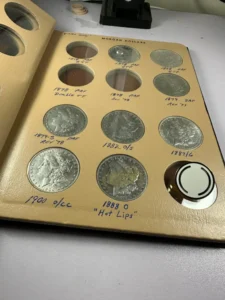Collecting things isn’t just a fun hobby; it can also be a smart way to grow your money over time. From rare coins to luxury watches, some items keep going up in value the longer you hold onto them. But not all collectibles are worth the same, and knowing what to collect makes all the difference.
In this guide, you’ll find 10 types of collectibles that have a strong history of keeping or increasing their value. You’ll also learn what makes them special, what to look out for, and how to know if something is truly worth collecting.
Top 10 Collectible Categories with Long-Term Value
Based on historical performance, market stability, and long-term appreciation potential, here are 10 collectible categories with strong prospects for retaining or increasing value over decades:
1. Fine Art (Blue-Chip Artists)
Why: Works by established masters (Picasso, Monet, Warhol) or critically acclaimed contemporary artists have consistently appreciated due to scarcity, cultural significance, and institutional demand.
Key: Provenance (ownership history), condition, and artist reputation are paramount.
2. Rare Coins & Precious Metals (Numismatics & Bullion)
Why: Gold/silver bullion hedges against inflation. Rare coins (key dates, low mintage, historical significance) combine intrinsic metal value with numismatic premiums driven by scarcity and collector demand.
Key: Grading (PCGS/NGC certification) is essential for rare coins.
3. High-Grade Vintage Comic Books
Why: Key issues (1st appearances, Golden/Silver Age) in high grades (CGC 9.0+) have shown explosive growth due to pop culture influence and extreme scarcity of well-preserved copies.
Key: Condition is EVERYTHING. Focus on iconic characters (Superman, Batman, Spider-Man).
4. Iconic Luxury Watches (Patek Philippe, Rolex)
Why: Combines craftsmanship, engineering, brand prestige, and scarcity. Certain vintage Rolex (Paul Newman Daytona) and complicated Pateks (Nautilus, Aquanaut) have outperformed stocks.
Key: Original parts, condition, box/papers, and model rarity.
5. Rare Stamps (Philately)
Why: The original collectible. Extremely rare stamps (British Guiana 1c, Inverted Jenny) have global appeal and a long track record of value retention among dedicated collectors.
Key: Condition, centering, gum integrity, and expert certification (e.g., Philatelic Foundation).
6. Classic Cars (Ferrari, Porsche, Mercedes)
Why: Iconic models (Ferrari 250 GTO, Porsche 911 RS) combine engineering, design, nostalgia, and scarcity. Top-tier examples have appreciated significantly.
Key: Originality, documented history, low mileage, and exceptional condition. Maintenance costs are high.
7. Rare Whisky (Scotch Single Malts, Japanese Whisky)
Why: Demand for bottles from closed distilleries (Port Ellen, Brora) or limited editions (Macallan Fine & Rare) has soared globally. Value hinges on distillery reputation, age, and scarcity.
Key: Sealed bottles, impeccable provenance, and proper storage are critical.
8. High-End Designer Handbags (Hermès, Chanel, Vintage)
Why: Iconic bags (Hermès Birkin/Kelly, Chanel Classic Flap) hold or exceed retail value, especially in rare colors/materials/conditions.
Key: Brand, model, condition, rarity, and authenticity (huge counterfeit market).
9. Antique Jewelry (Signed Pieces, Gemstones)
Why: High-quality gemstones (natural, untreated, rare colors) and pieces from famous houses (Cartier, Van Cleef & Arpels, Tiffany) retain intrinsic value and collectible appeal.
Key: Quality of stones (color, clarity, cut, carat), craftsmanship, designer/house, condition.
10. Vintage Posters (Film, Travel, Advertising)
Why: Iconic imagery (Moulin Rouge, early Disney, travel posters, Art Deco) by known artists. Appreciated based on art, nostalgia, and rarity.
Key: Artist, subject matter, condition (folds, tears, color), and rarity (small original print runs).
Crucial Considerations for Long-Term Value
Authenticity & Provenance
Undocumented items lose huge value.
Get expert verification.
Condition
“Mint” or “near mint” is paramount for most categories.
Restoration often decreases value.
Rarity
True scarcity drives long-term appreciation.
Mass-produced items rarely hold value.
Quality over Quantity
One exceptional piece is better than ten mediocre ones.
Storage/Preservation
Proper care (climate control for art/wine, safe storage for watches/jewelry) is non-negotiable.
Market Liquidity
Some categories (art, wine, watches) have stronger secondary markets than others (stamps, specific antiques).
Passion Matters
Collect what you love.
Markets fluctuate, but enjoyment is constant.
Don’t invest purely speculatively without expertise.
Beware of Fads
Avoid categories driven purely by short-term hype (many modern “collectibles” like some NFTs, mass-produced “limited” items).
How To Know Collectibles That Are Likely To Increase In High Value
1. Study Historical Performance
Look at past trends in that category (e.g., vintage watches, comic books, sneakers).
Research how similar items have appreciated over 10–20 years.
Platforms like eBay, Heritage Auctions, and collectibles market reports show price histories.
2. Prioritize Rarity + Demand
Ask:
Is it hard to find now?
Will people still want this in 10–20 years?
Example: 1st edition Pokémon cards have both rarity and cultural nostalgia.
3. Look for Cultural Significance
Items tied to pop culture, major events, or iconic brands tend to last.
Example: Michael Jordan memorabilia, vintage Barbie dolls, early Apple products.
Ask:
Will this still matter to people in the future?
4. Verify Authenticity
Seek collectibles with proof of origin or grading (e.g., PSA, CGC, GIA, COAs).
Authenticated items are far more likely to retain or grow in value.
5. Focus on Quality and Condition
Buy only items in excellent condition or get them professionally restored or graded.
Even rare items lose value if they’re damaged.
6. Watch Emerging Trends
Follow collector communities, auction houses, YouTube experts, and niche blogs.
Look for “undervalued” niches that are gaining attention.
Example: 10 years ago, few thought sneakers would become major investment items.
7. Choose Timeless Over Trendy
Trendy collectibles (like NFTs or TikTok merch) may spike fast but drop sharply.
Timeless collectibles (e.g., fine art, luxury watches, rare coins) have proven track records.
8. Evaluate Supply Chain
Ask:
Was this mass-produced or limited edition?
The smaller the original batch, the more likely it is to gain value.
9. Rely on Third-Party Expertise
Use platforms like:
eBay Sold Listings (for market price trends)
WorthPoint (archive of antique/collectible sales)
Auction houses like Sotheby’s or Christie’s
10. Invest with Passion
If you love what you’re collecting, even if the value doesn’t rise, it’s still meaningful.
Passionate collectors often spot hidden gems because they understand the market better.
Focusing on truly rare, high-quality, historically significant items within these established categories offers the best chance for long-term value retention and appreciation. Always do thorough research and consult specialists before making significant purchases.






